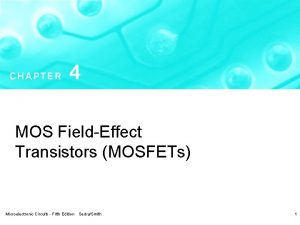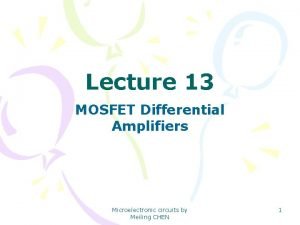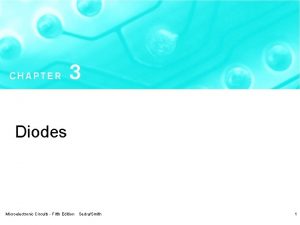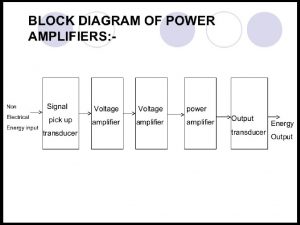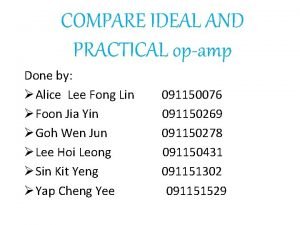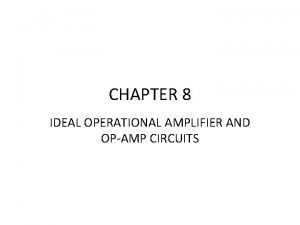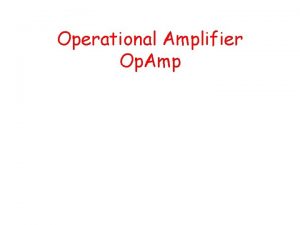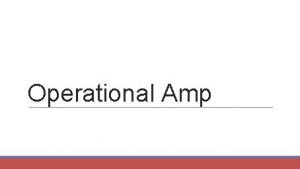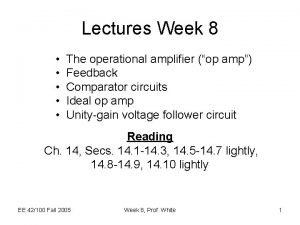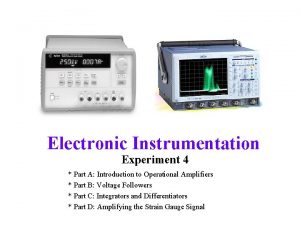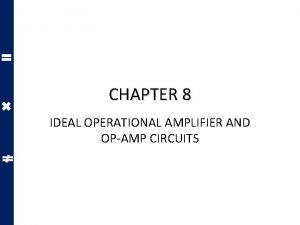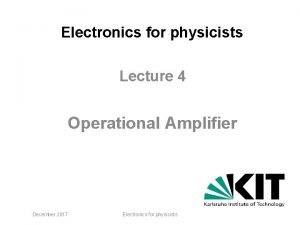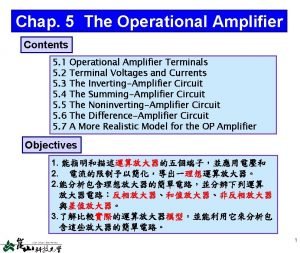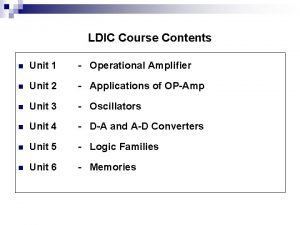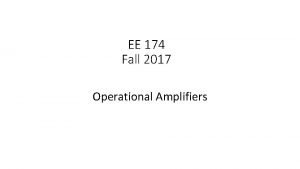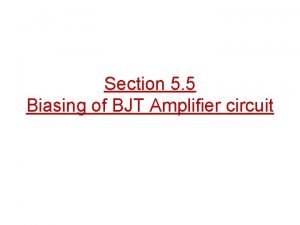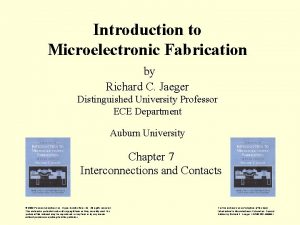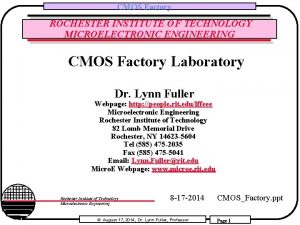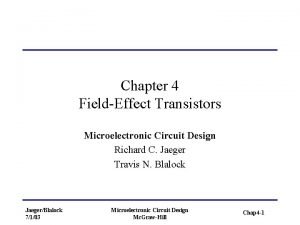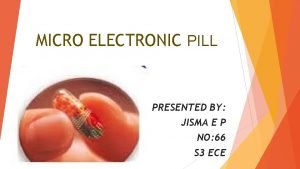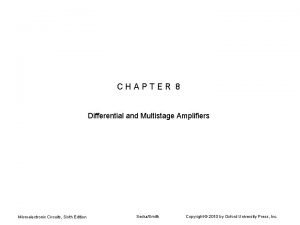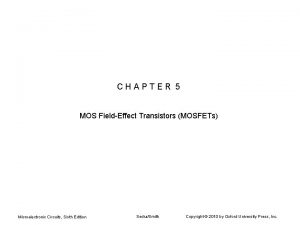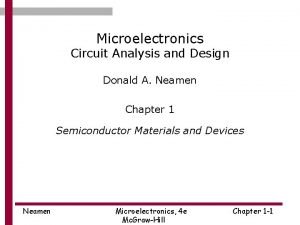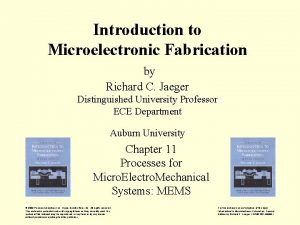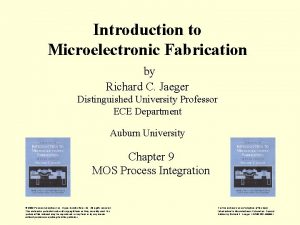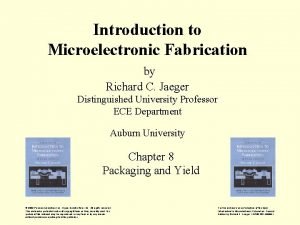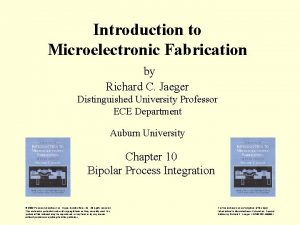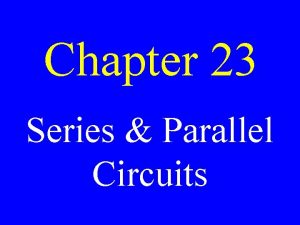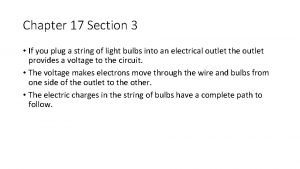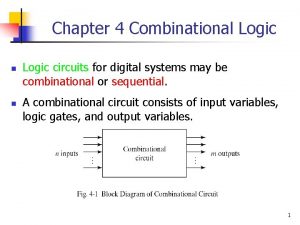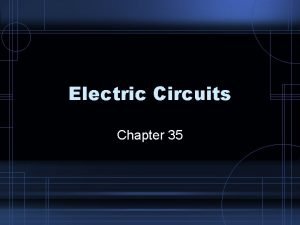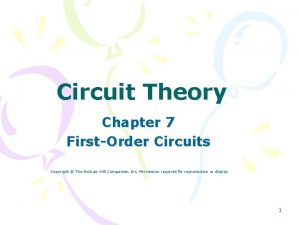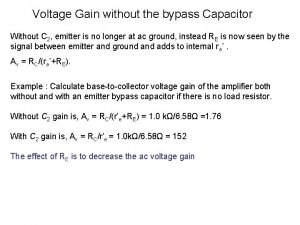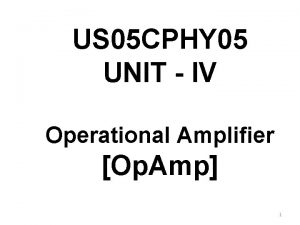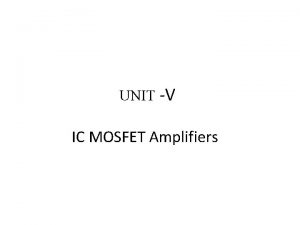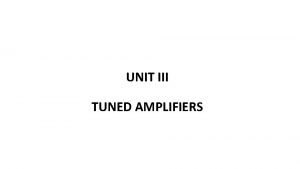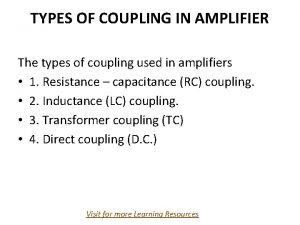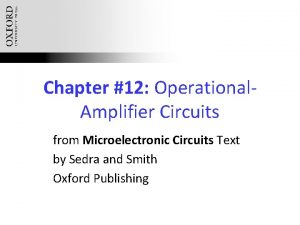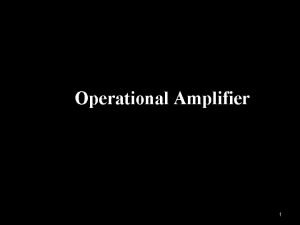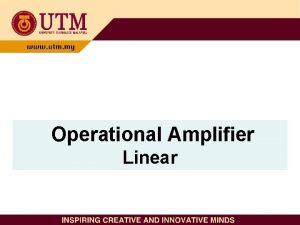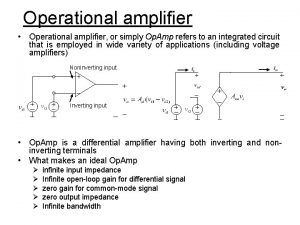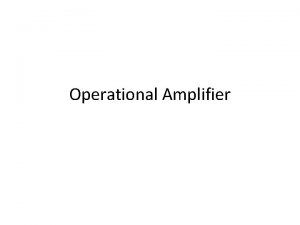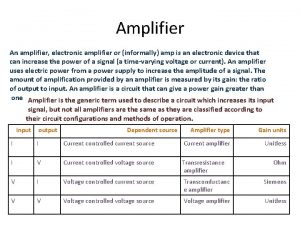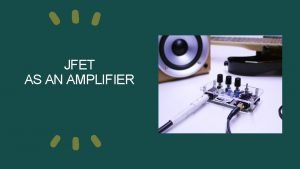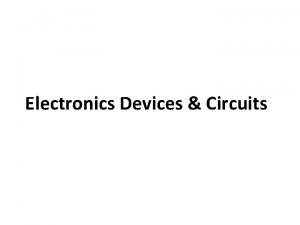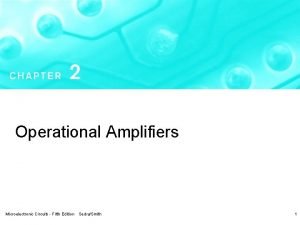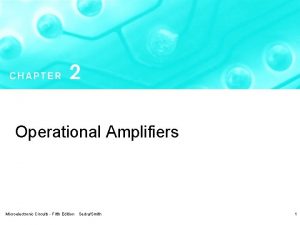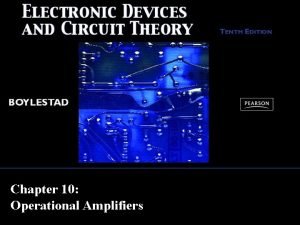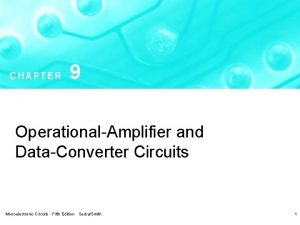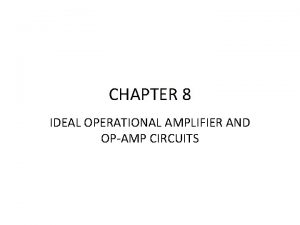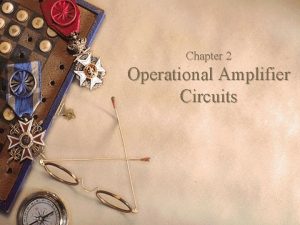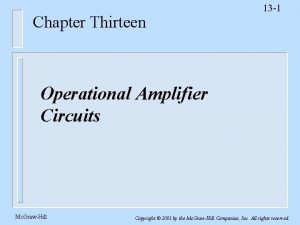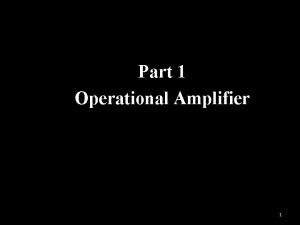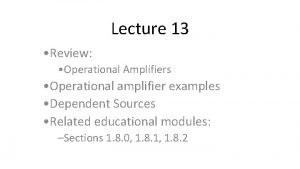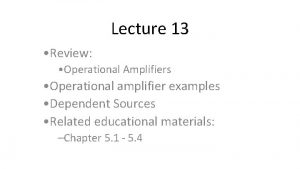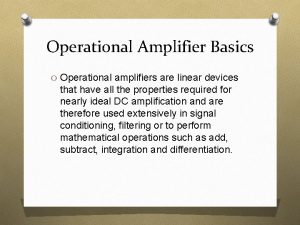Chapter 12 Operational Amplifier Circuits from Microelectronic Circuits















































- Slides: 47

Chapter #12: Operational. Amplifier Circuits from Microelectronic Circuits Text by Sedra and Smith Oxford Publishing The College of New Jersey (TCNJ) – ELC 251 Electronics I http: //anthony. deese. googlepages. com Based on Textbook: Microelectronic Circuits by Adel S. Sedra (0195323033)

Introduction § IN THIS CHAPTER YOU WILL LEARN § The design and analysis of the two basic CMOS opamp architectures: the two-stage circuit and the single-stage, folded cascode circuit. § The complete circuit of an analog IC classic: the 741 op-amp. Though 40 years old, the 741 circuit includes so many interesting and useful design techniques that its study is still a must. § Applications of negative feedback within op-amp circuits to achieve bias stability and increased CMRR. The College of New Jersey (TCNJ) – ELC 251 Electronics I http: //anthony. deese. googlepages. com Based on Textbook: Microelectronic Circuits by Adel S. Sedra (0195323033)

Introduction § IN THIS CHAPTER YOU WILL LEARN § How to break a large analog circuit into its recognizable blocks, to be able to make the analysis amendable to a pencil-and-paper approach – which is the best way to learn design. § Some of the modern techniques employed in the design of low-voltage single-supply BJT op amps. § Most importantly, how the different topics we learned about in the preceding chapters come together in the design of the most important analog IC – the op amp. The College of New Jersey (TCNJ) – ELC 251 Electronics I http: //anthony. deese. googlepages. com Based on Textbook: Microelectronic Circuits by Adel S. Sedra (0195323033)

12. 1. The Two Stage CMOS Op Amp § Two-stage op amp is shown in Figure 12. 1. § It was studied in Section 8. 6. 1 as example of multi-stage CMOS amplifier. Figure 12. 1 The basic two-stage CMOS op-amp configuration. The College of New Jersey (TCNJ) – ELC 251 Electronics I http: //anthony. deese. googlepages. com Based on Textbook: Microelectronic Circuits by Adel S. Sedra (0195323033)

12. 1. 1. The Circuit § Two Stages: § Differential Pair Q 1/Q 2. § Biased by current source Q 5 § Fed by a reference current IREF § Current Mirror Load Q 3/Q 4. § Frequency Compensation § Voltage Gain 20 V/V to 60 V/V § Reasonable Common-Mode Rejection Ratio (CMRR) The College of New Jersey (TCNJ) – ELC 251 Electronics I http: //anthony. deese. googlepages. com Based on Textbook: Microelectronic Circuits by Adel S. Sedra (0195323033)

12. 1. 1. Input Common. Mode Range and Output Swing The College of New Jersey (TCNJ) – ELC 251 Electronics I http: //anthony. deese. googlepages. com Based on Textbook: Microelectronic Circuits by Adel S. Sedra (0195323033)

12. 1. 3. Voltage Gain § Consider simplified equivalent circuit model for smallsignal operation of CMOS amplifier. § Figure 12. 2. § Input resistance is practically infinite (Rin). § First-stage transconductance (Gm 1) is equal to values for Q 1 and Q 2. § Since Q 1 and Q 2 are operated at equal bias currents (I/2) and equal overdrive voltages, equation (12. 7) applies. The College of New Jersey (TCNJ) – ELC 251 Electronics I http: //anthony. deese. googlepages. com Based on Textbook: Microelectronic Circuits by Adel S. Sedra (0195323033)

12. 1. 1. Input Common. Mode Range and Output Swing The College of New Jersey (TCNJ) – ELC 251 Electronics I http: //anthony. deese. googlepages. com Based on Textbook: Microelectronic Circuits by Adel S. Sedra (0195323033)

12. 1. 1. Input Common. Mode Range and Output Swing The College of New Jersey (TCNJ) – ELC 251 Electronics I http: //anthony. deese. googlepages. com Based on Textbook: Microelectronic Circuits by Adel S. Sedra (0195323033)

12. 1. 1. Input Common. Mode Range and Output Swing The College of New Jersey (TCNJ) – ELC 251 Electronics I http: //anthony. deese. googlepages. com Based on Textbook: Microelectronic Circuits by Adel S. Sedra (0195323033) Figure 12. 2: Small-signal equivalent circuit for the op amp in Fig. 12. 1.

12. 1. 4. Common-Mode Rejection Ratio § CMRR of two-stage amplifier is determined by first stage § CMRR = [gm 1(ro 2||ro 4)[2 gm 3 RSS] § RSS is output resistance of the bias source Q 5 § CMRR is of the order of (gmro)2 § This is high. § Gmro is proportional to VA/VOV § CMRR is increased if long channels are used. The College of New Jersey (TCNJ) – ELC 251 Electronics I http: //anthony. deese. googlepages. com Based on Textbook: Microelectronic Circuits by Adel S. Sedra (0195323033)

12. 1. 5. Frequency Response The College of New Jersey (TCNJ) – ELC 251 Electronics I http: //anthony. deese. googlepages. com Based on Textbook: Microelectronic Circuits by Adel S. Sedra (0195323033)

The College of New Jersey (TCNJ) – ELC 251 Electronics I http: //anthony. deese. googlepages. com Based on Textbook: Microelectronic Circuits by Adel S. Sedra (0195323033)

Figure 12. 4: Typical frequency response of the two-stage op amp. The College of New Jersey (TCNJ) – ELC 251 Electronics I http: //anthony. deese. googlepages. com Based on Textbook: Microelectronic Circuits by Adel S. Sedra (0195323033)

12. 1. 5. Frequency Response The College of New Jersey (TCNJ) – ELC 251 Electronics I http: //anthony. deese. googlepages. com Based on Textbook: Microelectronic Circuits by Adel S. Sedra (0195323033)

Figure 12. 5: Small-signal equivalent circuit of the op amp in Fig. 12. 1 with a The College of New Jersey (TCNJ) – ELC 251 Electronics I http: //anthony. deese. googlepages. com resistance R included in series with CC. Based on Textbook: Microelectronic Circuits by Adel S. Sedra (0195323033)

12. 1. 6. Slew Rate Figure 12. 6: A unity-gain follower with a large step input. Since the output voltage cannot change immediately, a large differential voltage appears between the op. The College of New Jersey (TCNJ) – ELC 251 Electronics I http: //anthony. deese. googlepages. com amp input terminals. Based on Textbook: Microelectronic Circuits by Adel S. Sedra (0195323033)

12. 1. 6. Slew Rate Figure 12. 7: the. Electronics two-stage CMOS op-amp of Fig. 12. 1 when a large The College of New. Model Jersey (TCNJ)of – ELC 251 I http: //anthony. deese. googlepages. com differential voltage is applied. Based on Textbook: Microelectronic Circuits by Adel S. Sedra (0195323033)

Relationship Between SR and ft § Simple relationship exists between unity-gain bandwidth (ft) and slew rate. § Equations (12. 31) through (12. 40). § SR = 2 pft. VOV § Slew rate is determined by the overdrive voltage at which first-stage transistors are operated. § For a given bias current I, a larger VOV is obtained if Q 1 and Q 2 are p-channel devices. The College of New Jersey (TCNJ) – ELC 251 Electronics I http: //anthony. deese. googlepages. com Based on Textbook: Microelectronic Circuits by Adel S. Sedra (0195323033)

12. 1. 7. Power Supply Rejection Ratio § mixed-signal circuit – IC chip which combines analog and digital devices. § Switching activity in digital portion results in ripple within power supplies. § This ripple may affect op amp output. § power-supply rejection ratio – the ability of a circuit to eliminate any ripple in the circuit power supplies. § PSRR is generally improved through utilization of capacitors. The College of New Jersey (TCNJ) – ELC 251 Electronics I http: //anthony. deese. googlepages. com Based on Textbook: Microelectronic Circuits by Adel S. Sedra (0195323033)

12. 1. 7. Power Supply Rejection Ratio The College of New Jersey (TCNJ) – ELC 251 Electronics I http: //anthony. deese. googlepages. com Based on Textbook: Microelectronic Circuits by Adel S. Sedra (0195323033)

12. 1. 8. Design Trade -Offs § The performance of the two-stage CMOS amplifier are primarily determined by two design parameters: § Length (L) of channel of each MOSFET § Overdrive voltage (VOV) at which transistor is operated. § transition frequency (f. T) – is defined below. It determined high-frequency operation. The College of New Jersey (TCNJ) – ELC 251 Electronics I http: //anthony. deese. googlepages. com Based on Textbook: Microelectronic Circuits by Adel S. Sedra (0195323033)

12. 2. The Folded. Cascode CMOS Op Amp Figure 12. 8: Structure of the folded-cascode CMOS op amp. The College of New Jersey (TCNJ) – ELC 251 Electronics I http: //anthony. deese. googlepages. com Based on Textbook: Microelectronic Circuits by Adel S. Sedra (0195323033)

12. 7. 1. The Circuit Figure. The 12. 9: ANew more complete circuit for the folded-cascode CMOS amplifier of Fig. College of Jersey (TCNJ) – ELC 251 Electronics I http: //anthony. deese. googlepages. com Based on Textbook: Microelectronic Circuits by Adel S. Sedra (0195323033)12. 8.

12. 2. 2. Input Common. Mode Range and Output Swing The College of New Jersey (TCNJ) – ELC 251 Electronics I http: //anthony. deese. googlepages. com Based on Textbook: Microelectronic Circuits by Adel S. Sedra (0195323033)

12. 2. 3. Voltage Gain The College of New Jersey (TCNJ) – ELC 251 Electronics I http: //anthony. deese. googlepages. com Based on Textbook: Microelectronic Circuits by Adel S. Sedra (0195323033)

12. 7. 1. The Circuit Figure. The 12. 10: equivalent circuit of the folded-cascode CMOS amplifier. College of Small-signal New Jersey (TCNJ) – ELC 251 Electronics I http: //anthony. deese. googlepages. com Note this circuit. Circuits is in effect an operational transconductance amplifier (OTA). Based onthat Textbook: Microelectronic by Adel S. Sedra (0195323033)

12. 3. The 741 Op. Amp Circuit § Sections 12. 3. through 12. 6 focus on the 741 op-amp circuit. § Figure 12. 13. provides a circuit schematic. § The design uses many transistors, few resistors. § 741 requires two power supplies. § VCC = VEE = 15 V The College of New Jersey (TCNJ) – ELC 251 Electronics I http: //anthony. deese. googlepages. com Based on Textbook: Microelectronic Circuits by Adel S. Sedra (0195323033)

12. 7. 1. The Circuit Figure 12. 13: The 741 op-amp circuit: Q 11, Q 12, and R 5 generate a reference bias current; IREF. Q 10, Q 9, and Q 8 bias the input stage, which is composed of Q 1 to Q 7. The second gain stage is composed of Q 16 and Q 17 with Q 13 B acting as active load. The class AB output stage is formed by Q 14 and Q 20 with biasing devices Q 13 A, The College Newan Jersey (TCNJ)buffer – ELC 251 Q 23. Electronics I Q 18, and Q 19, ofand input Transistors Q 15, Q 21, Q 24, and Q 22 serve to protect the amplifier http: //anthony. deese. googlepages. com against short circuits and are normally cut off. Based on Textbook: Microelectronic Circuits by Adeloutput S. Sedra (0195323033)

12. 3. 3. The Input Stage § 741 consists of three-stages: § Input Differential Stage (Q 1 through Q 7) § Emitter Followers: Q 1, Q 2 § Differential Common-Base: Q 3, Q 4 § Load Circuit: Q 5, Q 6, Q 7 § Biasing: Q 8, Q 9, Q 10 § Intermediate Single-Ended High-Gain Stage § Output-Buffering Stage (other transistors) The College of New Jersey (TCNJ) – ELC 251 Electronics I http: //anthony. deese. googlepages. com Based on Textbook: Microelectronic Circuits by Adel S. Sedra (0195323033)

12. 3. 4. The Second Stage § Consists of Q 16, Q 17, and Q 13 B § Emitter Follower: Q 16 § Common-Emitter: Q 17 § Load: Q 13 B § Output of second stage is taken at collector of Q 17. § Capacitor CC is connected in feedback path of second stage. § Frequency compensation using Miller Technique. The College of New Jersey (TCNJ) – ELC 251 Electronics I http: //anthony. deese. googlepages. com Based on Textbook: Microelectronic Circuits by Adel S. Sedra (0195323033)

12. 3. 5. The Output Stage § Provides low output resistance. § Able to supply relatively large load current. § With minimal power dissipation. § Consists of Q 14 and Q 20. § Complementary pair. § Transistors Q 18 and Q 19 are fed by current source Q 13 A and bias transistors Q 14 and Q 20. The College of New Jersey (TCNJ) – ELC 251 Electronics I http: //anthony. deese. googlepages. com Based on Textbook: Microelectronic Circuits by Adel S. Sedra (0195323033)

12. 3. 6. Device Parameters § npn: IS = 10 -14 A, b = 200, VA = 125 V § pnp: IS = 10 -14 A, b = 50, VA = 50 V § Q 13 A and Q 13 B: ISA = 0. 25(10 -14)A, ISB = 0. 75(10 -14)A § These devices are non-standard. § Q 14 and Q 20 will be assumed to have area three times of the standard device – for increased loading. The College of New Jersey (TCNJ) – ELC 251 Electronics I http: //anthony. deese. googlepages. com Based on Textbook: Microelectronic Circuits by Adel S. Sedra (0195323033)

12. 4. DC Analysis of the 741 The College of New Jersey (TCNJ) – ELC 251 Electronics I http: //anthony. deese. googlepages. com Based on Textbook: Microelectronic Circuits by Adel S. Sedra (0195323033)

12. 7. 1. The Circuit The College of New Jersey (TCNJ) – ELC 251 Electronics I http: //anthony. deese. googlepages. com Based on Textbook: Microelectronic Circuits by Adel S. Sedra (0195323033) Figure 12. 14: The Widlar current source that biases the input stage.

12. 7. 1. The Circuit The College of New Jersey (TCNJ) – ELC 251 Electronics I http: //anthony. deese. googlepages. com Based on Textbook: Microelectronic Circuits by Adel S. Sedra (0195323033) Figure 12. 15: The dc analysis of the 741 input stage.

12. 7. 1. The Circuit The College of New Jersey (TCNJ) – ELC 251 Electronics I http: //anthony. deese. googlepages. com Based on Textbook: Microelectronic Circuits by Adel S. Sedra (0195323033) Figure 12. 16: The dc analysis of the 741 input stage, continued.

12. 4. DC Analysis of the 741 The College of New Jersey (TCNJ) – ELC 251 Electronics I http: //anthony. deese. googlepages. com Based on Textbook: Microelectronic Circuits by Adel S. Sedra (0195323033)

12. 5. Small Signal Analysis of 741 § One may use small-signal analysis (as in previous chapters) to analyze linear behavior of the 741. § Figures 12. 18 – 12. 21 describe this process for input stage. § Figures 12. 25 – 12. 27 describe this process for gain stage. § Figures 12. 28 – 12. 30 describe this process for output stage. The College of New Jersey (TCNJ) – ELC 251 Electronics I http: //anthony. deese. googlepages. com Based on Textbook: Microelectronic Circuits by Adel S. Sedra (0195323033)

12. 5. Small Signal Analysis of 741 Figure The 12. 21: Small-signal equivalent circuit for the input stage of the 741 op amp. College of New Jersey (TCNJ) – ELC 251 Electronics I http: //anthony. deese. googlepages. com Based on Textbook: Microelectronic Circuits by Adel S. Sedra (0195323033)

12. 5. Small Signal Analysis of 741 The College of New Jersey (TCNJ) – ELC 251 Electronics I http: //anthony. deese. googlepages. com Based on Textbook: Microelectronic Circuits by Adel S. Sedra (0195323033) Figure 12. 25: Small-signal equivalent-circuit model of the second stage.

Summary § Most CMOS op-amps are designed to operate as part of a VLSI circuit and thus required to drive only small capacitive loads. Therefore, most do not have a lowoutput-resistance stage. § There are basically two approaches to the design of CMOS op-amps: a two-stage configuration and a singlestage topology using the folded-cascode circuit. § In the two-stage CMOS op-amp, approximately equal gains are realized in the two stages. The College of New Jersey (TCNJ) – ELC 251 Electronics I http: //anthony. deese. googlepages. com Based on Textbook: Microelectronic Circuits by Adel S. Sedra (0195323033)

Summary § The threshold mismatch together with the low transconductance of the input stage result in a larger input offset voltage for the CMOS op-amps than for bipolar units. § Miller compensation is employed in the two-stage CMOS op-amp, but a series resistor is required to place the transmission zero at either s = infinity or on the negative real axis. § CMOS op-amps have better slew rates (than alt’s). The College of New Jersey (TCNJ) – ELC 251 Electronics I http: //anthony. deese. googlepages. com Based on Textbook: Microelectronic Circuits by Adel S. Sedra (0195323033)

Summary § Use of the cascode configuration increases the gain of a CMOS amplifier stage by about two orders of magnitude, thus making possible a single-stage op-amp. § The dominant pole of the folded-cascode op-amp is determined by the total capacitance at the output CL. Increasing CL improves the phase margin at the expense of reducing bandwidth. § By using two complementary input differential pairs in parallel, the common-mode range may be extended. The College of New Jersey (TCNJ) – ELC 251 Electronics I http: //anthony. deese. googlepages. com Based on Textbook: Microelectronic Circuits by Adel S. Sedra (0195323033)

Summary § The output voltage swing of the folded-cascode op-amp may be extended by utilizing a wide-swing current mirror in place of the cascode mirror. § The internal circuit of the 741 op-amp embodies many of the design techniques employed in bipolar analog integrated circuits. § The 741 circuit consists of an input differential stage, a high-gain single-ended second stage, and a class AB output stage. It is the basis for many other devices. The College of New Jersey (TCNJ) – ELC 251 Electronics I http: //anthony. deese. googlepages. com Based on Textbook: Microelectronic Circuits by Adel S. Sedra (0195323033)

Summary § To obtain low input offset voltage and current, and high CMRR, the 741 input stage is designed to be perfectly balanced. The CMRR is increased by common-mode feedback, which also stabilizes the dc operating point. § To obtain high input resistance and low input bias current, the input stage of the 741 is operated as a very low current level. § The use of Miller Frequency compensation in the 741 circuit enables locating the dominant pole at a very low frequency, while utilizing a relatively small compensating capacitance. The College of New Jersey (TCNJ) – ELC 251 Electronics I http: //anthony. deese. googlepages. com Based on Textbook: Microelectronic Circuits by Adel S. Sedra (0195323033)

Summary § Two-stage op-amps may be modeled as a transconductance amplifier feeding an ideal integrator with CC as the integrating capacitor. § The slew rate of a two-stage op-amp is determined by the first-stage bias current and frequency-compensation capacitor. § While the 741 and similar op-amps nominally operate from 15 V power supplies, modern BJT op-amps typically utilize a single ground-referenced supply of only 2 or 3 V. The College of New Jersey (TCNJ) – ELC 251 Electronics I http: //anthony. deese. googlepages. com Based on Textbook: Microelectronic Circuits by Adel S. Sedra (0195323033)
 Microelectronic circuits
Microelectronic circuits Mos differential pair
Mos differential pair Small signal model
Small signal model Difference between power and voltage amplifier
Difference between power and voltage amplifier Comparison of ideal and practical op-amp
Comparison of ideal and practical op-amp Operational amplifier experiment
Operational amplifier experiment Conclusion operational amplifier
Conclusion operational amplifier Amplifier
Amplifier Penguat operasional
Penguat operasional Opamp
Opamp Operational amplifier experiment
Operational amplifier experiment Operational amplifier inverter
Operational amplifier inverter Operational amplifier
Operational amplifier Inverting summer
Inverting summer Inverting and non inverting amplifier difference
Inverting and non inverting amplifier difference History of op amp
History of op amp Operational amplifiers
Operational amplifiers Bjt amplifier biasing
Bjt amplifier biasing Introduction to microelectronic fabrication jaeger 1990
Introduction to microelectronic fabrication jaeger 1990 Rit microelectronic engineering
Rit microelectronic engineering Technology nodes
Technology nodes Microelectronic pills
Microelectronic pills Circuit
Circuit Microelectronic
Microelectronic Temperature coefficient
Temperature coefficient Jaeger metal fabrication
Jaeger metal fabrication Introduction to microelectronic fabrication jaeger 1990
Introduction to microelectronic fabrication jaeger 1990 Introduction to microelectronic fabrication jaeger 1990
Introduction to microelectronic fabrication jaeger 1990 Introduction to microelectronic fabrication jaeger 1990
Introduction to microelectronic fabrication jaeger 1990 Series parallel circuit current
Series parallel circuit current Fundamentals of electric circuits chapter 4 solutions
Fundamentals of electric circuits chapter 4 solutions Electric current
Electric current Chapter 35 electric circuits
Chapter 35 electric circuits Chapter 23 series and parallel circuits answers
Chapter 23 series and parallel circuits answers Chapter 20 electric circuits
Chapter 20 electric circuits Chapter 17 section 3 circuits answer key
Chapter 17 section 3 circuits answer key 9
9 Fundamentals of electric circuits chapter 7 solutions
Fundamentals of electric circuits chapter 7 solutions Chapter 35 electric circuits answers
Chapter 35 electric circuits answers Ohm's law and electric power worksheet answers
Ohm's law and electric power worksheet answers Quadruple 2 to 1 line multiplexer truth table
Quadruple 2 to 1 line multiplexer truth table Chapter 35 electric circuits
Chapter 35 electric circuits First order circuit
First order circuit Common collector configuration circuit diagram
Common collector configuration circuit diagram Circuit solution
Circuit solution Ic mosfet amplifiers
Ic mosfet amplifiers Single tuned amplifier working
Single tuned amplifier working Types of coupling in multistage amplifier
Types of coupling in multistage amplifier
